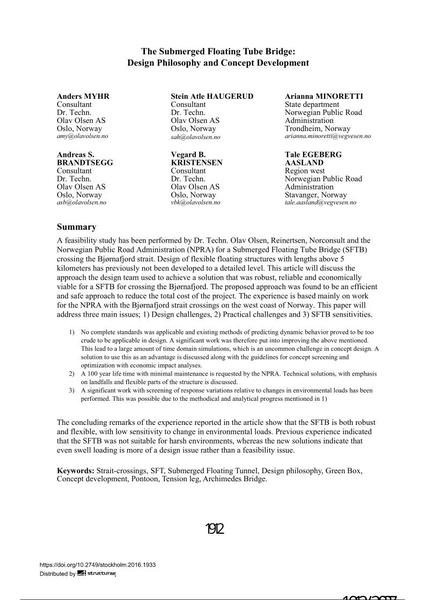The Submerged Floating Tube Bridge: Design Philosophy and Concept Development

|
|
|||||||||||
Bibliografische Angaben
| Autor(en): |
Anders Myhr
(Consultant Dr. Techn, Olav Olsen AS Oslo, Norway)
Andreas Saur Brandtsegg (Consultant Dr. Techn, Olav Olsen AS Oslo, Norway) Vegard B. Kristensen (State department Norwegian Public Road Administration Trondheim, Norway ) Arianna Minoretti (Consultant Dr. Techn, Olav Olsen AS Oslo, Norway) Stein Atle Haugerud (Consultant Dr. Techn., Olav Olsen AS Oslo, Norway) Tale Egeberg Aasland (Region west Norwegian Public Road Administration Stavanger, Norway) |
||||
|---|---|---|---|---|---|
| Medium: | Tagungsbeitrag | ||||
| Sprache(n): | Englisch | ||||
| Tagung: | IABSE Congress: Challenges in Design and Construction of an Innovative and Sustainable Built Environment, Stockholm, Sweden, 21-23 September 2016 | ||||
| Veröffentlicht in: | IABSE Congress Stockholm, 2016 | ||||
|
|||||
| Seite(n): | 1912-1926 | ||||
| Anzahl der Seiten (im PDF): | 15 | ||||
| Jahr: | 2016 | ||||
| DOI: | 10.2749/stockholm.2016.1933 | ||||
| Abstrakt: |
A feasibility study has been performed by Dr. Techn. Olav Olsen, Reinertsen, Norconsult and the Norwegian Public Road Administration (NPRA) for a Submerged Floating Tube Bridge (SFTB) crossing the Bjørnafjord strait. Design of flexible floating structures with lengths above 5 kilometers has previously not been developed to a detailed level. This article will discuss the approach the design team used to achieve a solution that was robust, reliable and economically viable for a SFTB for crossing the Bjørnafjord. The proposed approach was found to be an efficient and safe approach to reduce the total cost of the project. The experience is based mainly on work for the NPRA with the Bjørnafjord strait crossings on the west coast of Norway. This paper will address three main issues; 1) Design challenges, 2) Practical challenges and 3) SFTB sensitivities.
The concluding remarks of the experience reported in the article show that the SFTB is both robust and flexible, with low sensitivity to change in environmental loads. Previous experience indicated that the SFTB was not suitable for harsh environments, whereas the new solutions indicate that even swell loading is more of a design issue rather than a feasibility issue. |
||||
| Stichwörter: |
Schwimmkörper Ponton
|
||||

